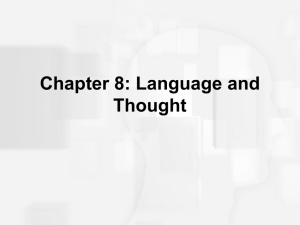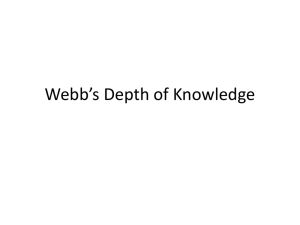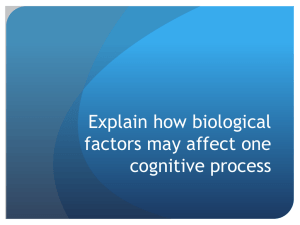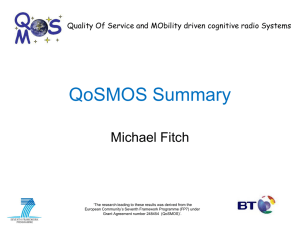Ch 8 Power Point
advertisement
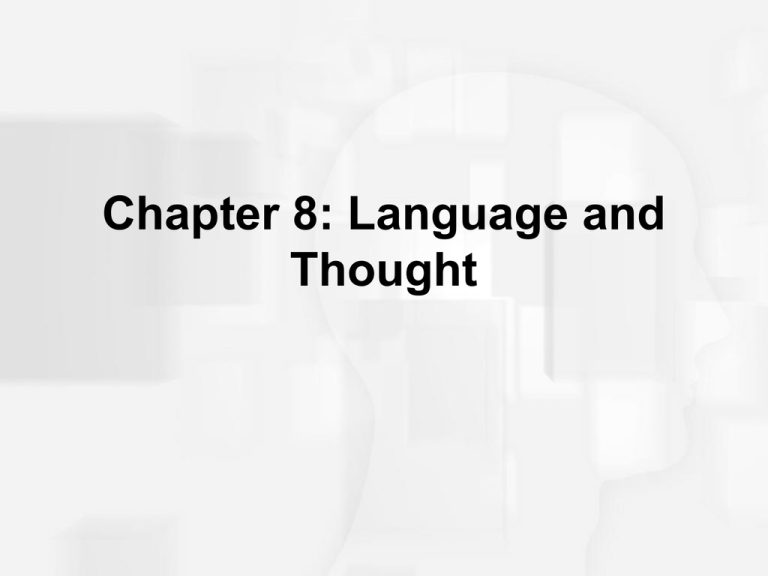
Chapter 8: Language and Thought The Cognitive Revolution • 19th Century focus on the mind – Introspection • Behaviorist focus on overt responses – arguments regarding incomplete picture of human functioning • Empirical study of cognition – 1956 conference – Simon and Newell – first computer program simulating human problem solving – Chomsky – new model that changed the study of language – Miller – famous paper arguing for the 7 plus or minus two capacity of STM Language: Turning Thoughts into Words • Cognitive science has since grown into a robust, interdisciplinary field focusing on language, problem solving, decision-making, and reasoning • Language is defined as consisting of symbols that convey meaning, plus rules for combining those symbols, that can be used to generate an infinite variety of messages Language: Turning Thoughts into Words • Properties of Language – Symbolic: people use spoken sounds and written words to represent objects, actions, events, and ideas – Semantic: meaningful – Generative: a limited number of symbols can be combined in an infinite number of ways to generate novel messages – Structured: there are rules that govern arrangement of words into phrases and sentences The Hierarchical Structure of Language • Basic sounds are combined into units with meaning, which are combined into words, which are combined into phrases, which are combined into sentences. • Phonemes = smallest speech units – 100 possible, English – about 40 • Morphemes = smallest unit of meaning – 50,000 in English, root words, prefixes, suffixes • Semantics = meaning of words and word combinations – Objects and actions to which words refer • Syntax = a system of rules for arranging words into sentences – Different rules for different languages – (Verb or subject first in a sentence?) Language Development: Milestones • Initial vocalizations similar across languages – Crying, cooing, babbling (of all phonemes.) • 6 months – babbling sounds begin to resemble surrounding language • 1 year – first word – similar cross-culturally – usually dada, mama, papa, etc – While few words are spoken (expressive language) at this stage, research indicates that very young children may actually understand (receptive language) more language than they can produce. Table 8.2 Overview of Typical Language Development Language Development: Milestones Continued • 18-24 months – vocabulary spurt, slow acquisition of new words suddenly spurts – fast mapping: process by which children map a word onto an underlying concept after only one exposure – Toddlers often make errors in using new words. Overextensions occur when a child incorrectly uses a word to describe a wider set of objects or actions than it is meant to…using the word ball for anything round Language Development: Milestones Continued • End of second year – children begin combining words to produce meaningful sentences – These sentences are characterized as telegraphic, because they resemble telegrams, consisting mainly of content words, with articles, prepositions, and other less critical words omitted…ex., “Give doll," – Researchers study the language of young children by calculating the MLU (mean length of utterance), the average length of their spoken statements (measured in morphemes). Language Development: Milestones Continued • End of third year – complex ideas, plural, past tense – Overregularization: generalizing grammatical rules incorrectly to irregular cases where they do not apply…”he goed home,” for example. • Years 4-5: Largest strides in developing language Bilingualism: Learning More Than One Language • Research findings: – Smaller vocabularies in one language, combined vocabularies average – Higher scores for middle-class bilingual subjects on cognitive flexibility, analytical reasoning, selective attention, and metalinguistic awareness – Slight disadvantage in terms of language processing speed – 2nd languages more easily acquired early in life – Greater acculturation facilitates acquisition • Acculturation is the degree to which a person is socially and psychologically integrated into a new culture Figure 8.4 Age and second language learning Can Animals Develop Language? • Researchers have attempted to teach language to a variety of animals, but the most success has been shown with chimpanzees. • Dolphins, sea lions, parrots, chimpanzees – One of the biggest problems in teaching human language to non-human animals is that the vocal apparatus is not the same – American Sign Language Can Animals Develop Language? • Allen and Beatrice Gardner (1969) – Chimpanzee - Washoe – 160 word vocabulary, combining them into simple sentences, but showing little evidence of mastering the rules of language Can Animals Develop Language? • Sue Savage-Rumbaugh – Bonobo chimpanzee – Kanzi • geometric symbols that represent words on a computer-monitored keyboard • the star pupil, has taught his younger sister much that he has learned about this system. Kanzi has acquired hundreds of words and has used them in thousands of combinations, many apparently spontaneous and rule governed – his receptive language appears much more developed, as he was able to carry out 72% of 660 spoken requests such as “Pour the Coke in the lemonade." Theories of Language Acquisition • Behaviorist – Skinner • learning of specific verbal responses • children acquire language through conditioning and imitation • Nativist – Chomsky • assert that humans have an innate capacity to learn the rules of language • Language Acquisition Device (LAD): facilitates language development. Theories of Language Acquisition • Interactionist: hold that biology and experience both make important contributions – Cognitive: asserts that language development is an important aspect of more general cognitive development, depending, like all development, on both maturation and experience. – Social communication: interpersonal communication has functional value and emphasizes the social context in which language evolves. Figure 8.5 Interactionist theories of language acquisition Theories of Language Acquisition • Emergentist theories: – neural circuits supporting language are not prewired, – rather emerge gradually in response to learning experiences via incremental changes in connectionist networks Problem Solving: Types of Problems • Greeno (1978) – three basic classes • Problems of inducing structure – Series completion and analogy problems – where people are required to discover relations among numbers, words, symbols, or ideas • Problems of arrangement – String problem and Anagrams – where people arrange the parts of a problem in a way that satisfies some criterion. These types of problems are often solved by insight, a sudden discovery of the correct solution following incorrect attempts based primarily on trial and error Problem Solving: Types of Problems • Problems of transformation – involve carrying out a sequence of transformations in order to reach a specific goal – Hobbits and orcs problem – Water jar problem Figure 8.6 Six standard problems used in studies of problem solving Effective Problem Solving • Well defined vs. ill defined problems – Problems vary in the degree to which they are well defined, where the initial state, the goal state, and the constraints are clearly specified; – most problems in the real world are illdefined, that is, one or more elements among the initial state, the goal state, and the constraints are incompletely or unclearly specified. Effective Problem Solving • Barriers to effective problem solving: – getting bogged down in Irrelevant Information – Functional Fixedness: the tendency to perceive an item only in terms of its most common use – Mental Set: people persist in using problem-solving strategies that have worked in the past – Unnecessary Constraints: assuming unnecessary constraints on the problem Figure 8.12 The tower of Hanoi problem Approaches to Problem Solving • Algorithms – An algorithm is a methodical, step-by-step procedure for trying all possible alternatives in searching for a solution to a problem – Guaranteed solution Approaches to Problem Solving • Heuristics – Shortcuts, guiding principles or “rules of thumb” used in solving problems – No guaranteed solution • Forming subgoals: allows one to solve part of the problem • Working backward: works well for a problem that has a specified end point • Searching for analogies: involves using a solution to a previous problem to solve a current one • Changing the representation of a problem: Figure 8.16 Representing the bird and train problem Culture, Cognitive Style, and Problem Solving • Some cultures foster field dependence, a reliance on external frames of reference. • Others foster field independence, reliance on internal frames of reference. People who are field independent tend to analyze and restructure problems more than those who are field dependent. – Western cultures inspire field independence – Cultural influence based in ecological demands: the necessary survival skills in a culture Culture, Cognitive Style, and Problem Solving • Holistic vs. analytic cognitive styles – Nisbett and colleagues (2001) argue that people from East Asian cultures display a holistic cognitive style – focusing on context and relationships among elements in a field (wholes). – People from Western cultures show an analytic cognitive style – focusing on objects and their properties rather than context (parts). • Nisbett argues that field-dependence/ independence is just one facet of a broader preference for holistic vs. analytic thinking • The caravan of a wealthy desert dweller is approaching an oasis after a long, hot day. He says to two of his lieutenant, To the one of you whose horse gets to the oasis last, I’ll give this camel laden with gold. Immediately they both stop. By the time the rear guard of the caravan reaches the two lieutenants, they have dismounted their horses and each is waiting on the sand for the other to become so hot and thirsty that getting to the oasis cannot be resisted. Finally, they tell the guard their dilemma and ask for help. He says two words to them, whereupon the lieutenants jump onto the horses and race toward the oasis. What did the guard tell them? Switch Horses! Decision Making: Evaluating Alternatives and Making Choices • Simon (1957) – theory of bounded rationality – holds that human decision making strategies are simplistic and often yield irrational results • Making Choices – Additive strategies: used to make choices by rating the attributes of each alternative and selecting the alternative with most desirable attributes – Elimination by aspects: making choices by gradually eliminating unattractive alternatives Decision Making: Evaluating Alternatives and Making Choices • Making Choices (cont.) • Research shows that people tend to use additive strategies when decisions involve relatively few options that need to be evaluated on only a few attributes • They shift to elimination by aspects when more options and factors are added to a decision making task • Research shows that people will often pursue useless information that will not alter their decisions when making choices Decision Making: Evaluating Alternatives and Making Choices – Risky decision making: making choices under conditions of uncertainty • Expected value: involves what you stand to gain • Subjective utility: what an outcome is personally worth to an individual…insurance and sense of security • Subjective probability: involves personal estimates of probabilities…often quite inaccurate Table 8.3 Application of the additive model to choosing an apartment Heuristics in Judging Probabilities • The availability heuristic: involves basing the estimated probability of an event on the ease with which relevant instances come to mind… – estimate divorce rate by recalling number of divorces among your friends’ parents • The representativeness heuristic: involves basing the estimated probability of an event on how similar it is to the typical prototype of that event – plays into the tendency to ignore base rates – guessing that Steve is a librarian because he looks like a librarian, even though you know that salespeople greatly outnumber librarians in the population Heuristics in Judging Probabilities • The conjunction fallacy: occurs when people estimate that the odds of two uncertain events happening together are greater than the odds of either event happening alone – this also appears to be due to the powerful nature of the representativeness heuristic • The alternative outcomes effect: occurs when peoples’ belief about whether an outcome will occur changes, depending on how alternative outcomes are distributed – even though the summed probability of the alternative outcomes is held constant. Figure 8.18 The conjunction fallacy Understanding Pitfalls in Reasoning About Decisions • The gambler’s fallacy: the belief that the odds of a chance event increase if the event hasn’t occurred recently • Overestimating the improbable: describes how people tend to greatly overestimate the likelihood of dramatic, vivid, but infrequent, events that receive heavy media coverage • Confirmation bias: tendency to seek information that supports one’s decisions and beliefs, while ignoring disconfirming information Understanding Pitfalls in Reasoning About Decisions • Belief perseverance: the tendency to hang onto beliefs in the face of contradictory evidence • The overconfidence effect: the tendency for people to put too much faith in their estimates, beliefs, and decisions, even when they should know better • Framing: how decision issues are posed or how choices are structured – People often allow a decision to be shaped by context or by the language in which it is presented. Evolutionary Analyses: Flaws in Decision Making and Fast and Frugal Heuristics • • While research shows that human decision making is replete with bias and error, evolutionary psychologists argue that this is due to the laboratory tasks used to measure it. They argue that traditional decision research has imposed an unrealistic standard in that questions are asked in ways that have nothing to do with the adaptive problems that humans have evolved to solve Evolutionary Analyses: Flaws in Decision Making and Fast and Frugal Heuristics • Cosmides and Tooby (1996) – argue that human decision making emerged to solve adaptive problems • such as finding food, shelter, and mates and dealing with allies and enemies • many reasoning errors disappear when problems are presented in ways that resemble the type of input humans would have processed in ancient times – Unrealistic standard of rationality – Problem solving research based on contrived, artificial problems Evolutionary Analyses: Flaws in Decision Making and Fast and Frugal Heuristics • Gigerenzer (2000) – argues that humans do not have the time, resources, or capacities to gather all information, consider all alternatives, calculate all probabilities and risks, and then make the statistically optimal decision – Instead, they use the fast and frugal route, making quick, one-reason decisions which yield inferences that are often just as accurate as much more elaborate and time-consuming strategies – Less than perfect but adaptive
